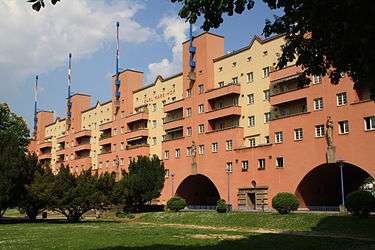Gemeindebau

Gemeindebau (plural: Gemeindebauten[1]) is a German word for "municipality building".[2] It refers to residential buildings erected by a municipality, usually to provide low-cost public housing.
Apartments in the building can be rented from the respective municipality.
Vienna
History
Gemeindebauten have become an important part of the architecture and culture of Vienna since the 1920s. Up to 1918, the housing conditions of Vienna's growing working class were appalling by modern standards. When the Social Democratic Party of Austria gained control of the municipal administration during Austria's First Republic (1918-1934) (so called "Red Vienna"), it began the project of improving living conditions for workers. A large number of Gemeindebauten, usually large residential estates, were built during that time. Including those buildings that were finished after the events of February 1934, 64,000 apartments where completed, which created housing space for about 220,000 people. Apartments were assigned on the basis of a point system favoring families and less affluent citizens.
The classic interwar Gemeindebauten typically have a main entrance with a large gate, through which one enters into a yard. Inside, there are trees and some greenery, where children can play without having to go out on the street. Apartments are accessed from the inside.
This fortress-like structure made the buildings adaptable to military use. Several Gemeindebauten in Vienna, most notably the Karl-Marx-Hof, were sites of fighting during the Austrian Civil War of February 1934, when they were defended as Social Democratic Party strongholds.
Gemeindebauten continued to be built after 1945, but the style of architecture changed over the decades. During the 1960s and 1970s, the municipality began to build extensive residential blocks consisting of high-rise buildings such as Großfeldsiedlung.
Characteristics
Gemeindebauten in Vienna can be recognized by the following text (or similar) which can usually be found in large red letters above the main entrance:
Wohnhausanlage der Gemeinde Wien errichtet in den Jahren 1925 bis 1927 aus den Mitteln der Wohnbausteuer
(Residential estate of the Municipality of Vienna built from 1925 to 1927 financed from the revenues of the Residential Construction Tax).
Larger Gemeindebauten are identified by their name. The names sometimes derive from the building's geographic location, but usually they are named after a person, sometimes after a famous freedom fighter (e.g., George Washington), but much more often after a famous socialist (e.g., Olof Palme) or a Viennese Social Democratic Party functionary.
Today, about 600,000 people (not necessarily poor ones), about a third of the population of Vienna, live in apartments owned by the city. As the Social Democratic Party has been firmly in control of the municipal administration since World War II, opposition politicians sometimes claim that party members are more likely to be assigned an apartment.
Notable Gemeindebauten
The most famous Gemeindebau in Vienna is the Karl-Marx-Hof.
References
External links
-
 Media related to Gemeindebau in Vienna at Wikimedia Commons
Media related to Gemeindebau in Vienna at Wikimedia Commons - Historical and architectural information on Germeindebauten in German